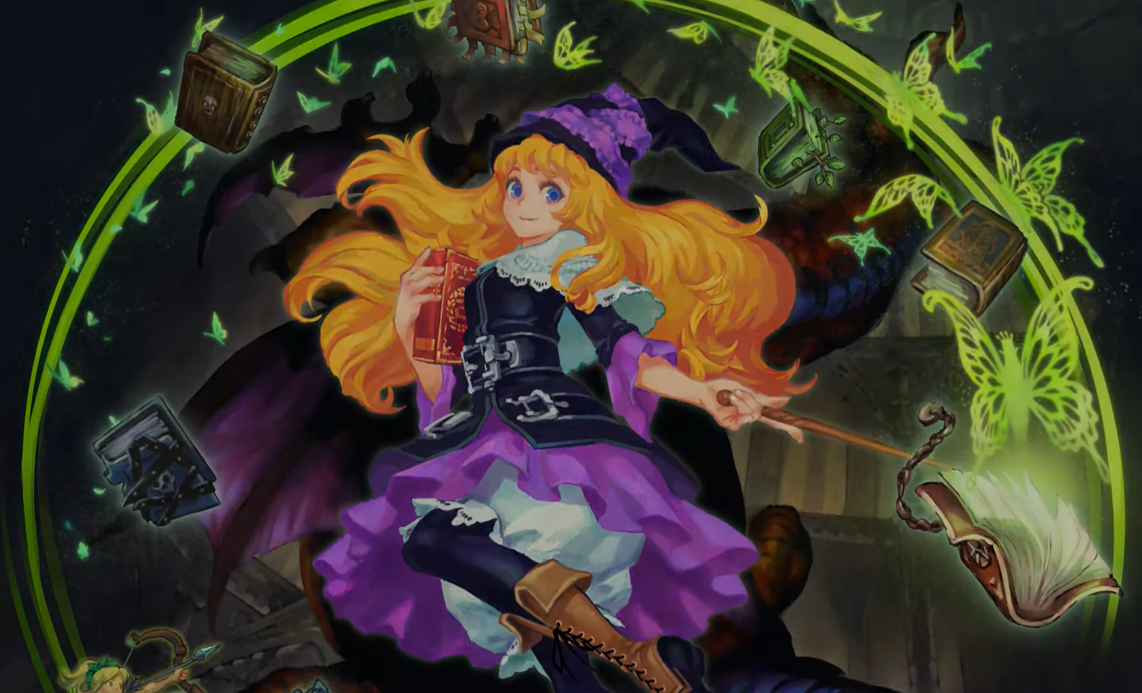GrimGrimoire OnceMore. Well, it may be Once More for some, but for me, this is the first time. I’m coming at this title a GrimVirgin, excited that Vanillaware are re-releasing back-catalogue games from 2007 that I never got chance to play, and as a massive fan/veteran of 13 Sentinels Aegis Rim. If there’s a single game that comes to mind over and over again in the last two years as a it’d-be-nice-to-play-that-again-game, it’s 13 Sentinels.
GrimGrimoire OnceMore shares with 13 Sentinels a real division into two sections; an involving visual novel narrative and real-time strategy battles. These two aspects work together, but could easily have been completely split apart like they are in 13 Sentinels. GrimGrimoire OnceMore’s combat system is a 2D RTS with a pinch of tower defense thrown in, in the same way Real Time Strategy games have always had a ‘wave’ or horde style to them before those terms really gained traction. Maybe the thing that really sets it apart is the setting of an RTS in a 2D vertical format, something I don’t think I’ve ever seen before or since.
OnceMore, With Feeling
Young magician-in-training Lillet Blan arrives at the Silver Star, an impossibly massive Babel-like tower so tall it reaches beyond the clouds. Here she will learn magic from an assortment of unhinged professors and make friends with her classmates – think Hogwarts but all in one huge unfeasible tower. She has free run of the place during the day to go about her studies, but at night she is warned to stay in her rooms, for the ghost of a malevolent witch stalks the halls, and secret doors are not to be trusted, lest she accidentally releases the Archmage. You can see where this is going.
One night, after just five days of scant tutorials/lessons, the Tower’s seal is broken and all hell breaks loose inside. Lillet must take all she’s learned and fight to stay alive, but before long the Archmage arrives, students and teachers alike fall to the onslaught and it’s all over.
I said you can see where this is going, but perhaps not. Because what happens next is Lillet wakes up OnceMore in her bed on the first night, aware of everything that transpires for the next five days. She has what she learned, the grimoires (spell books) she collected, but now needs to learn everything she can in order to defend the tower, and she has only five days to learn it. What began as a simple magical school story becomes far more interesting as a groundhog week scenario.
Most of the story and dialogue in GrimGrimoire OnceMore is told through 2D conversation screens, two or more characters on each side of the screen, visual-novel style. You don’t have control of any character and you can’t explore – you go from battle screen to conversation screen, and vice versa, with only menus in between.
As you might expect, loops two, three, and so on, slowly reveal more secrets and story as you work to find some way to avert disaster. The same five days are rehashed, just with Lillet meeting characters at different stages/days, until eventually she can find the answer, speed and help she needs in time. Overall I felt the story was fun from a plot perspective, but the characters were relatively unexplored due to spending most of the time meeting them over and over again for the first time and not really getting chance to get to know them. There wasn’t much room for character development even for Lillet herself. Even without the Groundhog Day scenario, the game is repetitive enough, and this narrative only fed that sense.
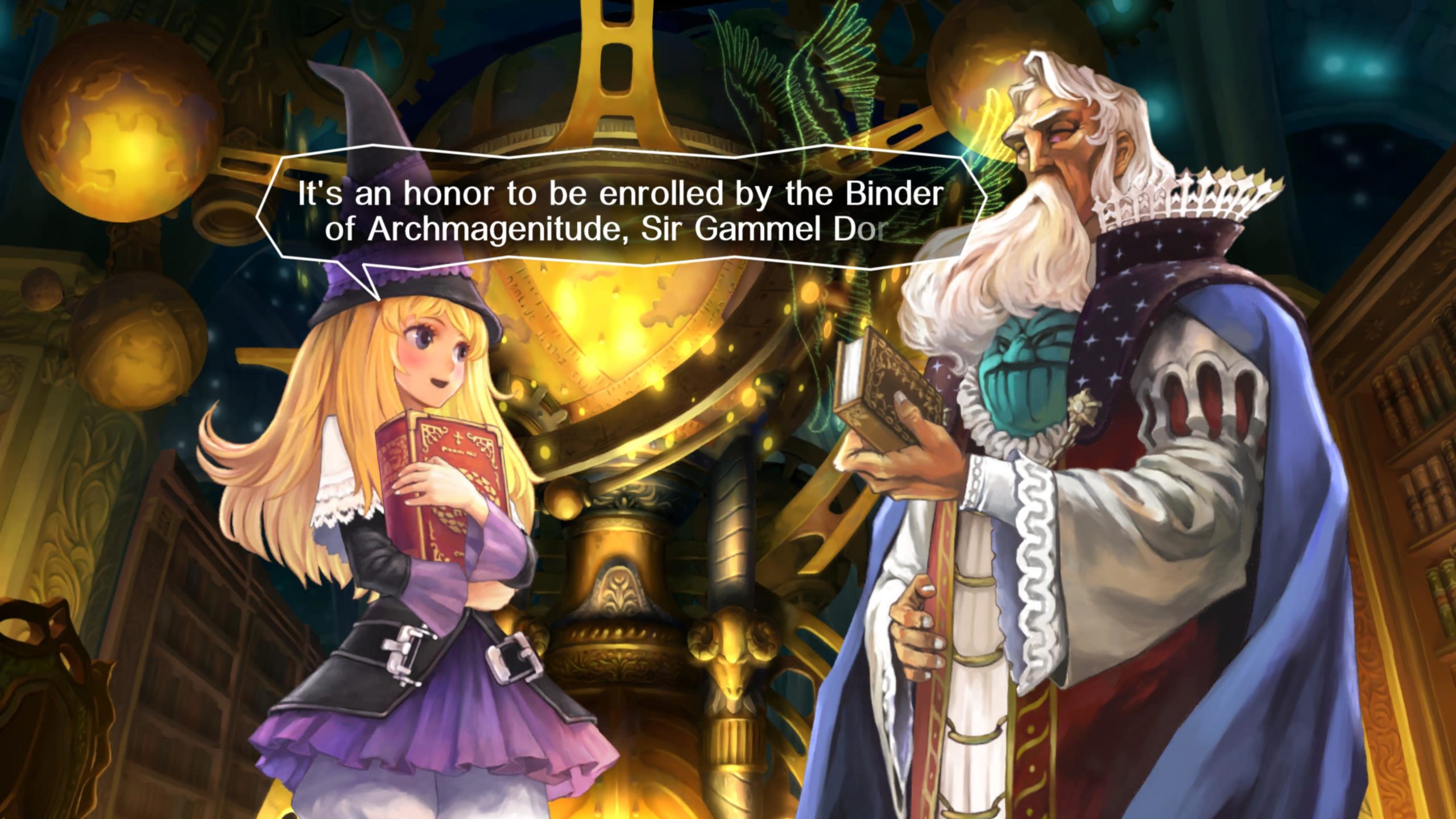
Hit Me Baby, OnceMore Time
The other side of the coin is the combat; managing small bases in the halls and stairways, building up units and attacking your enemies. Standard fair for anyone who’s played an RTS title, except that here it’s not a top-down perspective but a vertical one. Units climb stairs or fly between floors, and bases are arranged over multiple floors. The basics of combat are what you might expect – resource collection, in this case collecting Mana, and then using it to buy better and better units (here called familiars) to protect your Mana-gatherers.
Things start to get complicated when you add the different Grimoires. Each spellbook gives access to a new Rune, or base, and from it a new unit type, sometimes two. This means you end up with runes you need to build and find space for, for each unit type you want to use in battle, which can get cumbersome and complicated fast. Add to that four different families of runes, whose units all damage each other differently based on a kind of four-stage rock/paper/scissors, and it starts to feel overwhelming.
Many units across GrimGrimoire OnceMore can damage only one or the other type, meaning you’ve got to get to know your units and their strengths. An early example is a phantom, a large spirit knight, who can’t be hit by physical attacks, but can return a beating to physical units just fine. Finding the right unit that can tear through enemies without taking any damage in return – well, it’s a strategy player’s dream. It just involves a lot of memory, or trial and error.
With a few hours practice, the basics will fall into place, but I did find the complexity annoying and a barrier to the battles being all that fun. Having four types of base Grimoire and then three or four Runes for units isn’t particularly helpful, and I can’t see why this couldn’t have just been one Rune for each base type, with all the units inside. So a blue rune allows you to build all blue-type units etc. The system is complex enough, without a dozen different unit creators. If you want a diverse army, you will need to build half a dozen or more different ‘barracks’ runes.
As the story and loops progressed, the complexity of it all really started to hamstring me. There were just too many different unit types, each with its own strengths and weaknesses, to keep it all in my mind at once. You can pause, read about the units, and plan accordingly, but I still felt the tricky fingerwork sometimes of getting exactly which units you want to attack exactly which other enemy types you want, when there’s a bunch of types coming at you. It’s fiddly to say the least, especially with a control scheme that’s interesting if I’m being charitable.
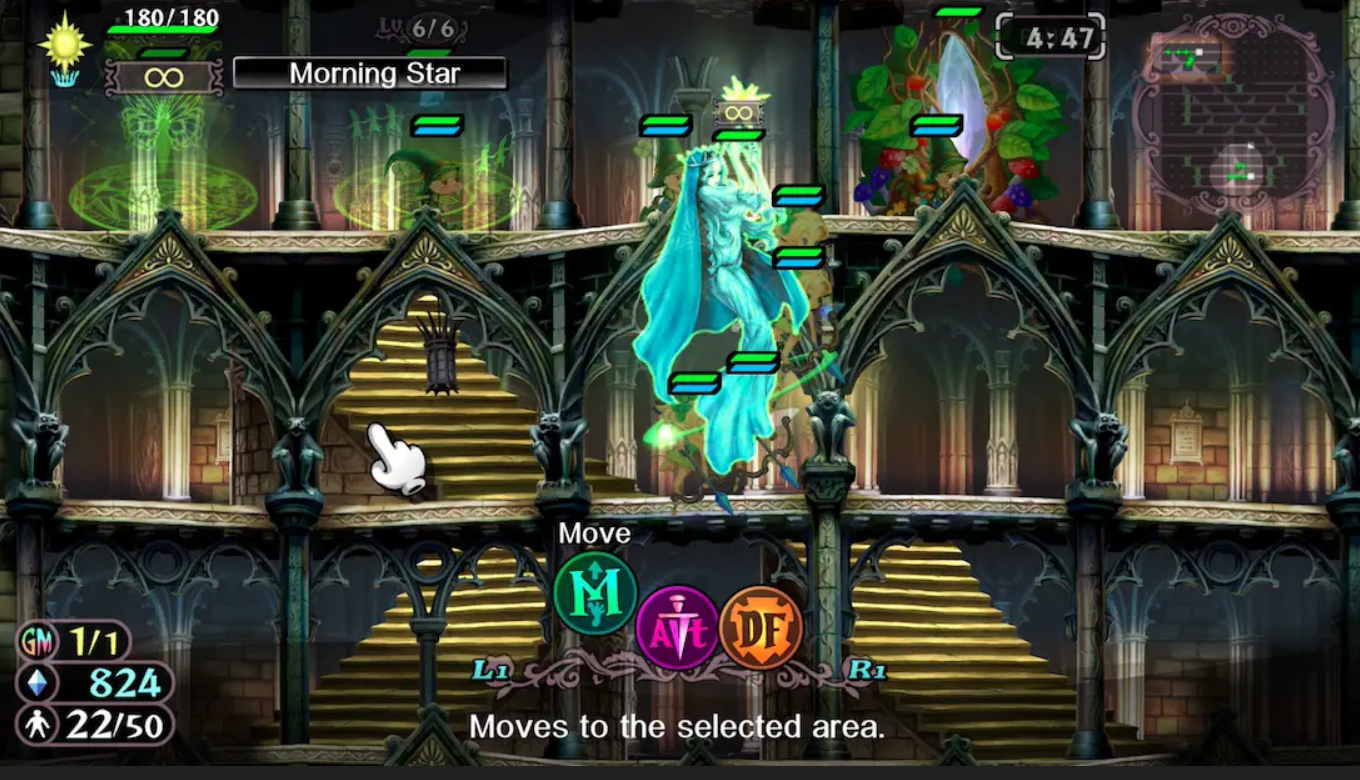
OnceMore Or Another
On the plus side is the fast-forward button on R2, which wasn’t in the original game. It’s incredibly useful and time-saving to just scrub forward through unit builds and gathering, not to mention large enemy health bars. The battles are streamlined to a great degree using this. I think if I’d had to slog through the battles at the original pace, it might have been the straw that broke the camel’s back.
As with many RTS games, battles can very easily degenerate into a numbers game, overwhelming your enemy with sheer volume on screen. The complexity of it can push players in this direction, as numbers are a simpler way to play than worrying about the complicated play of which stronger unit types. Fast forward through unit creation, fast forward through bludgeoning round the map knocking out runes. Battles can wrap up very fast with your trigger finger held down.
There is a lot of handholding and tutorials – it can take a good third of the game to really get the ability to use half the stuff. Annoying at the time, but in retrospect really necessary as it was easy to miss really important stuff in a combat system this detailed.
The story, battles and trials all form a bookcase on the GrimGrimoire OnceMore main menu, which I felt was a lovely design choice. This keeps an easy chronology for a complicated story. You can change difficulty level between/before any battles, and switch it back up again afterward – the system keeps a record of which battles were passed at different difficulties.
Beyond mana in battle, there’s a coin currency too that you use in the Skill Tree. Here you can upgrade the base Grimoires to give their respective units speed, health, and new abilities and more besides. Best thing about the skill tree is that you can just use it in battle. Need more power? Just find the skill tree for that rune and start upgrading, then go back to the battle and level up the rune to access the new powers you bought. It’s nice and accessible without having to make your upgrade choices before knowing what you need in battle.
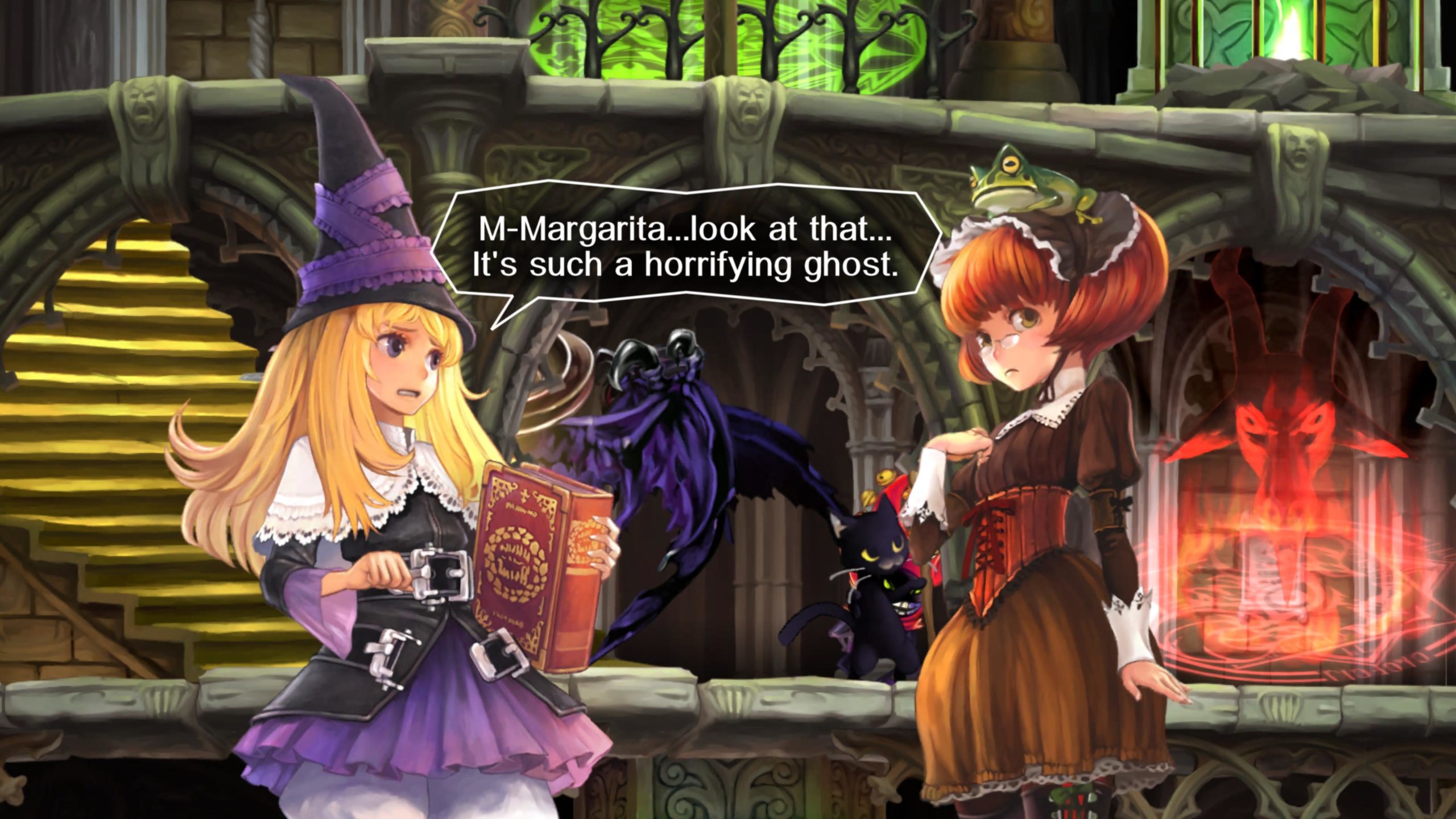
Once, More, Three Times A Lady
Graphically, Vanillaware really was, and still is, keeping 2D beauty alive in video games. The character designs in GrimGrimoire OnceMore are wonderful, the animation is lush. Backgrounds and artwork included are all beautiful and colourful. The sprite and units in battle are also nicely detailed and you get lovely artwork as rewards for your victories. Vanillaware have only grown since 2007 in this regard, and they have dozens of the best artists in gaming today.
2D has this ageless quality, meaning the game’s graphics look as good today as they did in 2007. However other aspects of design have moved on a lot since then. I get that it was 2007 and things were different then, but there is an unnecessary level of sexualisation in a handful of characters’ designs. The teacher Opalneria heaves with the effort of holding up her bosoms and yet wears a barely supportive negligee corset while out in the halls of a school. There’s also the far younger character of Amoretta (who is basically a problematic ‘Born-Sexy’ fantasy trope), who has all but bared breasts and lacey underwear on show. She’s a student (and more but I won’t spoil). This wouldn’t fly in Hogwarts! I don’t want to sound like a prude, but your skirt, sorry panties, are too short!
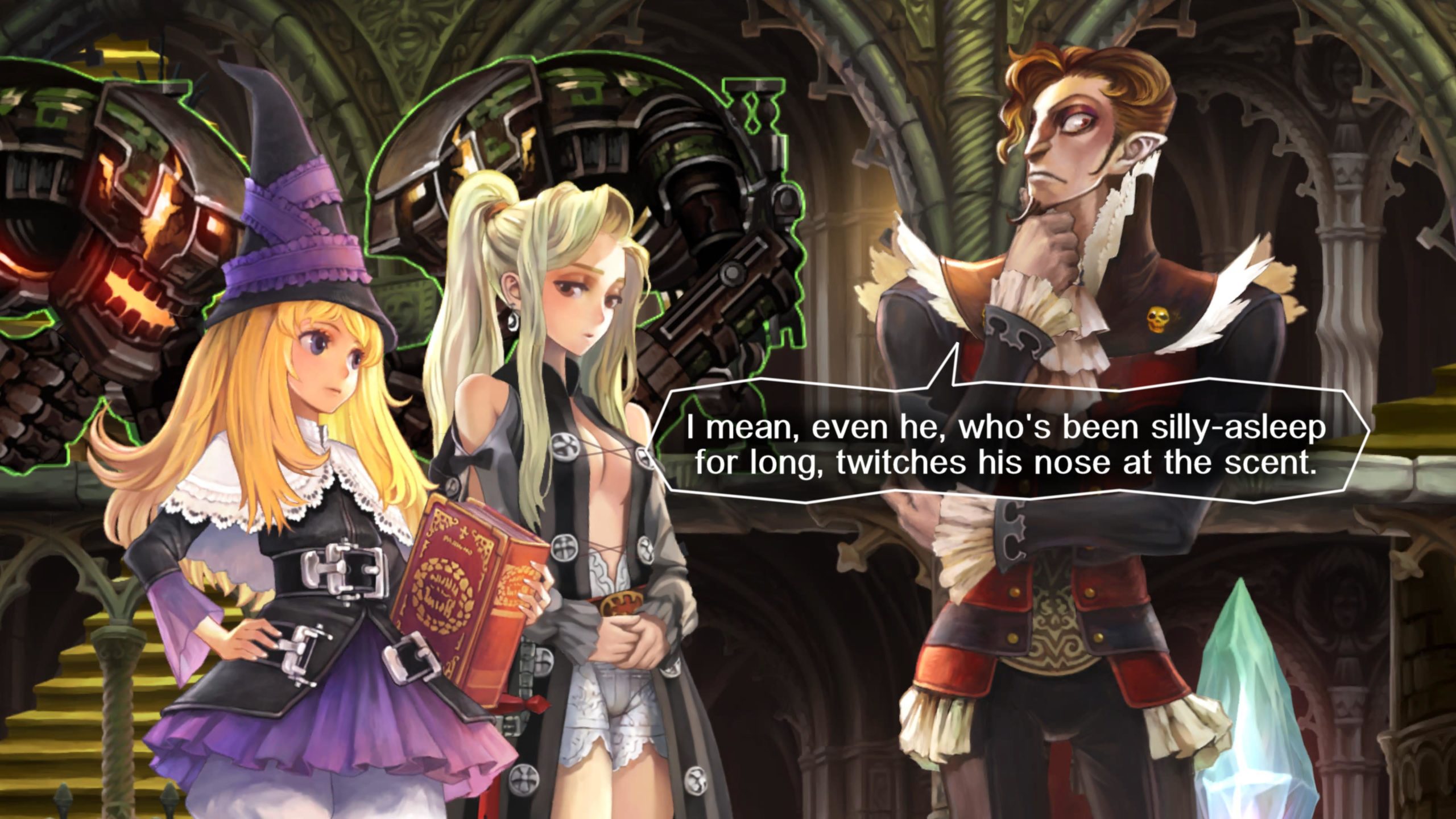
OnceMore Time
GrimGrimoire OnceMore is a great way to access and play one of Vanillaware’s beautiful backcatalogue games – games that are hard enough to play these days trapped on old consoles. Its narrative scenario is strong and will whisk you through its magical groundhog week in a 10-15 hour campaign. Battles can get difficult around the halfway point, which may well slow players down, unless they want to jump on easy mode.
The strategy game at its heart starts fun and feels unique with its vertical aspect, but quickly becomes repetitive and stale. There’s too much complexity, and faceless units have to do too much heavy lifting to keep your interest. I would have liked the characters to have avatars in battle that you could use, even if that meant losing entire battles if a character died. It would have given battles more personality and given characters more screen time to develop.
Where 13 Sentinels managed to keep my interest with characters I cared for, GrimGrimoire really fails to have a narrative arc for many of its cast. Despite beautiful artwork, character designs haven’t aged well, and can feel awkward and even problematic in 2023.
Vertical 2D battles in a giant tower are a great USP, but GrimGrimoire can’t reach the pinnacle with a battle system more bloated and complex than fun. Vanillaware’s beautiful signature artwork and clever narratives are as ageless now as they were back in 2007, but some design choices leave a bitter aftertaste.

GrimGrimoire OnceMore releases 7th April 2023 on PlayStation 5 (review platform), PlayStation 4, and Nintendo Switch in Europe.
Developer: Vanillaware
Publisher: Nippon Ichi Software
Disclaimer: In order to complete this review, we were provided with a promotional code from the publisher. For our full review policy, please go here.
If you enjoyed this article or any more of our content, please consider our Patreon.
Make sure to follow Finger Guns on our social channels. Twitter, Facebook, Twitch, Spotify or Apple Podcasts – to keep up to date on our news, reviews and features.
